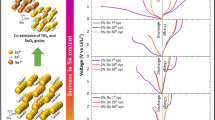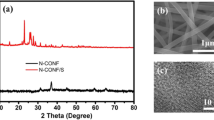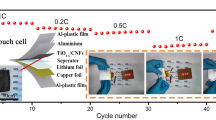Abstract
Metal chalcogenides with multiple lithium ions storage capability have received extensive attentions in recent years; however, their practical application is restricted by the structural instability and poor reversibility. Herein, a unique structure of N and S co-doped C/TiO2 nanofibers is reported to support SnS nanosheets for fast and ultra-stable lithium storage. The incorporation of TiO2 can notably suppress the excessive uncontrollable growth of SnS and improve the structural stability of the electrode material. The effects of the ratios between Ti and Sn and the corresponding synthesis temperatures on the structure and electrochemical properties of the electrodes have been systematically studied. The interface charge transfer behavior of SnS and TiO2 composite heterostructure was clarified by density functional theory (DFT) calculation. The electronic interaction SnS and TiO2 can effectively reduce the energy band gap and form a built-in electric field at the interface of the two phases. This is beneficial for the adsorption of lithium ion and consequently accelerate the reaction kinetics of the electrode material. After the two phases are combined, the agglomeration of SnS is effectively suppressed, and the overall conductivity of the composite is greatly improved. Furthermore, the synergistic effect induced by SnS and TiO2 enables the good stability of the electrode in both lithium-ion half-cells and full cells. This work can provide new insights toward improving the performance of alloy-type anodes.
Graphical abstract

摘要
近年来, 具有多重储锂能力的金属硫族化合物受到了广泛的关注, 但其结构不稳定性和可逆性差限制了其实际应用。本文报道了一种独特的N和S共掺杂C/TiO2纳米纤维结构, 用于支持SnS纳米片快速和超稳定的锂存储。TiO2的加入能显著抑制SnS的过度不可控生长, 提高电极材料的结构稳定性。系统研究了钛锡比和相应的合成温度对电极结构和电化学性能的影响。通过DFT计算, 阐明了SnS和TiO2复合异质结构的界面电荷转移行为。SnS和TiO2的电子相互作用能有效减小能带隙, 并在两相界面形成内置电场。这有利于锂离子的吸附, 从而加速电极材料的反应动力学。两相结合后, SnS的团聚得到有效抑制, 复合材料的整体电导率大大提高。此外, SnS和TiO2的协同作用使电极在锂离子半电池和全电池中都具有良好的稳定性。这项工作可以为提高合金型阳极的性能提供新的见解。项工作可以为提高合金型阳极的性能提供新的见解








Similar content being viewed by others
References
Yan YH, Liu XY, Yan J, Guan C, Wang J. Electrospun nanofibers for new generation flexible energy storage. Energy Environ Mater. 2020;4(4):502. https://doi.org/10.1002/eem2.12146.
Sun YM, Liu NA, Cui Y. Promises and challenges of nanomaterials for lithium-based rechargeable batteries. Nat Energy. 2016;1(7):16071. https://doi.org/10.1038/nenergy.2016.71.
Wei CH, Guo SG, Ma W, Mei SX, Xiang B, Gao B. Recent progress of bismuth-based electrode materials for advanced sodium ion batteries anode. Chin J Rare Met. 2021;45(5):611. https://doi.org/10.13373/j.cnki.cjrm.XY20070021.
Guo YM, Zhang LJ, XiLi DG, Kang J. Advances of carbon materials as loaders for transition metal oxygen/sulfide anode materials. Chin J Rare Met. 2021;45(10):1241. https://doi.org/10.13373/j.cnki.cjrm.XY20040016.
Li N, Liao S, Sun Y, Song HW, Wang CX. Uniformly dispersed self-assembled growth of Sb2O3/Sb@graphene nanocomposites on a 3D carbon sheet network for high Na-storage capacity and excellent stability. J Mater Chem A. 2015;3(11):5820. https://doi.org/10.1039/c4ta06825d.
Zhang Y, Zhou Q, Zhu JX, Yan QY, Dou SX, Sun WP. Nanostructured metal chalcogenides for energy storage and electrocatalysis. Adv Funct Mater. 2017;27(35):1702317. https://doi.org/10.1002/adfm.201702317.
Liu ZM, Lu TC, Song T, Yu XY, Lou XW, Paik U. Structure-designed synthesis of FeS2@C yolk-shell nanoboxes as a high-performance anode for sodium-ion batteries. Energ Environ Sci. 2017;10(7):1576. https://doi.org/10.1039/c7ee01100h.
Hou HS, Jing MJ, Zhang Y, Chen J, Huang ZD, Ji XB. Cypress leaf-like Sb as anode material for high-performance sodium-ion batteries. J Mater Chem A. 2015;3(34):17549. https://doi.org/10.1039/c5ta04703j.
Ying H, Han WQ. Metallic Sn-based anode materials: application in high-performance lithium-ion and sodium-ion batteries. Adv Sci. 2017;4(11):1700298. https://doi.org/10.1002/advs.201700298.
Ru J, He T, Chen B, Feng Y, Zu L, Wang Z, Zhang Q, Hao T, Meng R, Che R, Zhang C, Yang J. Covalent assembly of MoS2 nanosheets with SnS nanodots as linkages for lithium/sodium-ion batteries. Angew Chem Int Ed Engl. 2020;59(34):14621. https://doi.org/10.1002/anie.202005840.
Mo RW, Rooney D, Sun KN. Hollow germanium nanocrystals on reduced graphene oxide for superior stable lithium-ion half cell and germanium (lithiated)-sulfur battery. Energy Storage Mater. 2020;26:414. https://doi.org/10.1016/j.ensm.2019.11.013.
Wu Z, Ji S, Liu L, Xie T, Tan L, Tang H, Sun R. High-performance SiO/C as anode materials for lithium-ion batteries using commercial SiO and glucose as raw materials. Rare Met. 2021;40(5):1110. https://doi.org/10.1007/s12598-020-01445-x.
Li R, Zhang G, Wang Y, Lin Z, He C, Li Y, Ren X, Zhang P, Mi H. Fast ion diffusion kinetics based on ferroelectric and piezoelectric effect of SnO2/BaTiO3 heterostructures for high-rate sodium storage. Nano Energy. 2021;90:106591. https://doi.org/10.1016/j.nanoen.2021.106591.
Qiao X, Yang X, Zhang N, Wang X, Song Y, Zhai Y, Li D, Wang H. One-step in situ encapsulation of Ge nanoparticles into porous carbon network with enhanced electron/ion conductivity for lithium storage. Rare Met. 2021;40(9):2432. https://doi.org/10.1007/s12598-020-01662-4.
Chao D, Zhu C, Yang P, Xia X, Liu J, Wang J, Fan X, Savilov SV, Lin J, Fan HJ, Shen ZX. Array of nanosheets render ultrafast and high-capacity Na-ion storage by tunable pseudocapacitance. Nat Commun. 2016;7:12122. https://doi.org/10.1038/ncomms12122.
Jiang Y, Wei M, Feng JK, Ma YC, Xiong SL. Enhancing the cycling stability of Na-ion batteries by bonding SnS2 ultrafine nanocrystals on amino-functionalized graphene hybrid nanosheets. Energ Environ Sci. 2016;9(4):1430. https://doi.org/10.1039/c5ee03262h.
Ke G, Wu X, Chen H, Li W, Fan S, Mi H, Li Y, Zhang Q, He C, Ren X. Unveiling the reaction mechanism of an Sb2S3-Co9S8/NC anode for high-performance lithium-ion batteries. Nanoscale. 2021;13(47):20041. https://doi.org/10.1039/d1nr06069d.
Luu THT, Duong DL, Lee TH, Pham DT, Sahoo R, Han G, Kim YM, Lee YH. Monodispersed SnS nanoparticles anchored on carbon nanotubes for high-retention sodium-ion batteries. J Mater Chem A. 2020;8(16):7861. https://doi.org/10.1039/c9ta13136a.
Cheng DL, Yang LC, Liu JW, Hu RZ, Liu J, Pei K, Zhu M, Che RC. Nano-spatially confined and interface-controlled lithiation-delithiation in an in situ formed (SnS-SnS2-S)/FLG composite: a route to an ultrafast and cycle-stable anode for lithium-ion batteries. J Mater Chem A. 2019;7(25):15320. https://doi.org/10.1039/c9ta03996a.
Zhang S, Wang G, Zhang Z, Wang B, Bai J, Wang H. 3D graphene networks encapsulated with ultrathin SnS nanosheets@hollow mesoporous carbon spheres nanocomposite with pseudocapacitance-enhanced lithium and sodium storage kinetics. Small. 2019;15(14):1900565. https://doi.org/10.1002/smll.201900565.
Mukaibo H, Yoshizawa A, Momma T, Osaka T. Particle size and performance of SnS2 anodes for rechargeable lithium batteries. J Power Sources. 2003;119:60. https://doi.org/10.1016/S0378-7753(03)00125-3.
Tang Y, Zhang Y, Li W, Ma B, Chen X. ChemInform abstract: rational material design for ultrafast rechargeable lithium-ion batteries. Chem Soc Rev. 2015;44:5926. https://doi.org/10.1002/chin.201541270.
Yuan C, Wu HB, Xie Y, Lou XW. Mixed transition-metal oxides: design, synthesis, and energy-related applications. Angew Chem Int Ed Engl. 2014;53(6):1488. https://doi.org/10.1002/anie.201303971.
Li JP, Wu P, Lou FJ, Zhang P, Tang YW, Zhou YM, Lu TH. Mesoporous carbon anchored with SnS2 nanosheets as an advanced anode for lithium-ion batteries. Electrochim Acta. 2013;111:862. https://doi.org/10.1016/j.electacta.2013.08.104.
Ren YR, Wang JW, Huang XB, Ding JN. Three-dimensional SnS2 flowers/carbon nanotubes network: extraordinary rate capacity for sodium-ion battery. Mater Lett. 2017;186:57. https://doi.org/10.1016/j.matlet.2016.09.089.
Zhang YD, Zhu PY, Huang LL, Xie J, Zhang SC, Cao GS, Zhao XB. Few-layered SnS2 on few-layered reduced graphene oxide as Na-ion battery anode with ultralong cycle life and superior rate capability. Adv Funct Mater. 2015;25(3):481. https://doi.org/10.1002/adfm.201402833.
Lin M, Cheng DL, Liu JW, Ouyang LZ, Hu RZ, Liu J, Yang LC, Zhu M. Dual-carbon-confined SnS nanostructure with high capacity and long cycle life for lithium-ion batteries. Energy Environ Mater. 2020;4(4):562. https://doi.org/10.1002/eem2.12136.
Cheng D, Yang L, Hu R, Liu J, Zhu M. Microsized SnS/few-layer graphene composite with interconnected nanosized building blocks for superior volumetric lithium and sodium storage. Energy Environ Mater. 2020;4(2):229. https://doi.org/10.1002/eem2.12121.
Gou W, Zhou S, Cao X, Luo Y, Kong X, Chen J, Xie X, Pan A. Agitation drying synthesis of porous carbon supported Li3VO4 as advanced anode material for lithium-ion batteries. Rare Met. 2021;40(12):3466. https://doi.org/10.1007/s12598-021-01712-5.
Xiao J, Zhu Z, Zhang G, Li H, Li Y, Ren X, Zhang P, Mi H. Engineering hollow multi-shelled Co3O4 cubes to boost lithium storage performance. Appl Surf Sci. 2021;545:149022. https://doi.org/10.1016/j.apsusc.2021.149022.
Xiong XH, Yang CH, Wang GH, Lin YW, Ou X, Wang JH, Zhao BT, Liu ML, Lin Z, Huang K. SnS nanoparticles electrostatically anchored on three-dimensional N-doped graphene as an active and durable anode for sodium-ion batteries. Energy Environ Sci. 2017;10(8):1757. https://doi.org/10.1039/c7ee01628j.
Zhang Z, Zhao H, Teng Y, Chang X, Wierczek K. Carbon-sheathed MoS2 nanothorns epitaxially grown on CNTs: electrochemical application for highly stable and ultrafast lithium storage. Adv Energy Mater. 2017;8(7):1700174. https://doi.org/10.1002/aenm.201700174.
Yang X, Zhang L, Zhang F, Huang Y, Chen Y. Sulfur-infiltrated graphene-based layered porous carbon cathodes for high-performance lithium-sulfur batteries. ACS Nano. 2014;8(5):5208. https://doi.org/10.1021/nn501284q.
Zhao X, Cai W, Yang Y, Song X, Neale Z, Wang HE, Sui J, Cao G. MoSe2 nanosheets perpendicularly grown on graphene with Mo-C bonding for sodium-ion capacitors. Nano Energy. 2018;47:224. https://doi.org/10.1016/j.nanoen.2018.03.002.
Ge P, Hou H, Banks CE, Foster CW, Li S, Zhang Y, He J, Zhang C, Ji X. Binding MoSe2 with carbon constrained in carbonous nanosphere towards high-capacity and ultrafast Li/Na-ion storage. Energy Storage Mater. 2018;12:310. https://doi.org/10.1016/j.ensm.2018.02.012.
Fang G, Wu Z, Zhou J, Zhu C, Cao X, Lin T, Chen Y, Chao W, Pan A, Liang S. Observation of pseudocapacitive effect and fast ion diffusion in bimetallic sulfides as an advanced sodium-ion battery anode. Adv Energy Mater. 2018;8(19):1703155. https://doi.org/10.1002/aenm.201703155.
Chen J, Li S, Kumar V, Lee PS. Carbon coated bimetallic sulfide hollow nanocubes as advanced sodium ion battery anode. Adv Energy Mater. 2017;7(19):1700180. https://doi.org/10.1002/aenm.201700180.
Zhou X, Wan L, Guo Y. Binding SnO2 nanocrystals in nitrogen-doped graphene sheets as anode materials for lithium-ion batterie. Adv Mater. 2013;25(15):2152. https://doi.org/10.1002/adma.201300071.
Xiong X, Wang G, Lin Y, Wang Y, Ou X, Zheng F, Yang C, Wang JH, Liu M. Enhancing sodium ion battery performance by strongly binding nanostructured Sb2S3 on sulfur-doped graphene sheets. ACS Nano. 2016;10(12):10953. https://doi.org/10.1021/acsnano.6b05653.
Cheng X, Ran F, Huang Y, Zheng R, Yu H, Shu J, Xie Y, He Y. Insight into the synergistic effect of N, S co-doping for carbon coating layer on niobium oxide anodes with ultra-long life. Adv Funct Mater. 2021;31(19):2100311. https://doi.org/10.1002/adfm.202100311.
Mi H, Wang Y, Chen H, Sun L, Ren X, Li Y, Zhang P. Boosting Na-ion diffusion by piezoelectric effect induced by alloying reaction of micro red-phosphorus/BaTiO3/graphene composite anode. Nano Energy. 2019;66:104136. https://doi.org/10.1016/j.nanoen.2019.104136.
Youn DH, Stauffer SK, Xiao P, Park H, Nam Y, Dolocan A, Henkelman G, Heller A, Mullins CB. Simple synthesis of nanocrystalline tin sulfide/N-doped reduced graphene oxide composites as lithium ion battery anodes. ACS Nano. 2016;10(12):10778. https://doi.org/10.1021/acsnano.6b04214.
Yang J, Wang Y, Li W, Wang L, Fan Y, Jiang W, Luo W, Wang Y, Kong B, Selomulya C, Liu HK, Dou SX, Zhao D. Amorphous TiO2 shells: a vital elastic buffering layer on silicon nanoparticles for high-performance and safe lithium storage. Adv Mater. 2017;29(48):1700523. https://doi.org/10.1002/adma.201700523.
Wu L, Zheng J, Wang L, Xiong X, Shao Y, Wang G, Wang JH, Zhong S, Wu M. PPy-encapsulated SnS2 nanosheets stabilized by defects on a TiO2 support as a durable anode material for lithium-ion batteries. Angew Chem Int Ed Engl. 2019;58(3):811. https://doi.org/10.1002/anie.201811784.
Wang HE, Zhao X, Li XC, Wang ZY, Liu CF, Lu ZG, Zhang WJ, Cao GZ. rGO/SnS2/TiO2 heterostructured composite with dual-confinement for enhanced lithium-ion storage. J Mater Chem A. 2017;5(47):25056. https://doi.org/10.1039/c7ta08616d.
Xie X, Hu Y, Fang G, Cao X, Yin B, Wang Y, Liang S, Cao G, Pan A. Towards a durable high performance anode material for lithium storage: stabilizing N-doped carbon encapsulated FeS nanosheets with amorphous TiO2. J Mater Chem A. 2019;7(27):16541. https://doi.org/10.1039/c9ta03196k.
Tao H, Zhou M, Wang R, Wang K, Cheng S, Jiang K. TiS2 as an advanced conversion electrode for sodium-ion batteries with ultra-high capacity and long-cycle life. Adv Sci. 2018;5(11):1801021. https://doi.org/10.1002/advs.201801021.
Deng W, Chen X, Liu Z, Hu A, Tang Q, Li Z, Xiong Y. Three-dimensional structure-based tin disulfide/vertically aligned carbon nanotube arrays composites as high-performance anode materials for lithium ion batteries. J Power Sources. 2015;277:131. https://doi.org/10.1016/j.jpowsour.2014.12.006.
Xiong D, Zhang Q, Li W, Li J, Fu X, Cerqueira MF, Alpuim P, Liu L. Atomic-layer-deposited ultrafine MoS2 nanocrystals on cobalt foam for efficient and stable electrochemical oxygen evolution. Nanoscale. 2017;9(8):2711. https://doi.org/10.1039/c7nr00140a.
Wang Z, Dong Y, Li H, Zhao Z, Wu HB, Hao C, Liu S, Qiu J, Lou XW. Enhancing lithium-sulphur battery performance by strongly binding the discharge products on amino-functionalized reduced graphene oxide. Nat Commun. 2014;5:5002. https://doi.org/10.1038/ncomms6002.
Yan Y, Yin YX, Xin S, Guo YG, Wan LJ. Ionothermal synthesis of sulfur-doped porous carbons hybridized with graphene as superior anode materials for lithium-ion batteries. Chem Commun. 2012;48(86):10663. https://doi.org/10.1039/c2cc36234a.
Ma XL, Ning GQ, Kan YF, Ma YM, Qi CL, Chen B, Li YF, Lan XY, Gao JS. Synthesis of S-doped mesoporous carbon fibres with ultrahigh S concentration and their application as high performance electrodes in supercapacitors. Electrochim Acta. 2014;150:108. https://doi.org/10.1016/j.electacta.2014.10.128.
Li W, Zhou M, Li HM, Wang KL, Cheng SJ, Jiang K. A high performance sulfur-doped disordered carbon anode for sodium ion batteries. Energ Environ Sci. 2015;8(10):2916–21. https://doi.org/10.1039/c5ee01985k.
Yi Z, Han QG, Ju SS, Wu YM, Cheng Y, Wang LM. Fabrication of one-dimensional Sb@TiO2 composites as anode materials for lithium-ion batteries. J Electrochem Soc. 2016;163(13):A2641. https://doi.org/10.1149/2.0881613jes.
Madian M, Klose M, Jaumann T, Gebert A, Oswald S, Ismail N, Eychmuller A, Eckert J, Giebeler L. Anodically fabricated TiO2-SnO2 nanotubes and their application in lithium ion batteries. J Mater Chem A. 2016;4(15):5542. https://doi.org/10.1039/c6ta00182c.
Hassan FM, Batmaz R, Li J, Wang X, Xiao X, Yu A, Chen Z. Evidence of covalent synergy in silicon-sulfur-graphene yielding highly efficient and long-life lithium-ion batteries. Nat Commun. 2015;6:8597. https://doi.org/10.1038/ncomms9597.
Fei D, Shi L, Song P, Chen G, Zhang D. Design of orderly carbon coatings for SiO anodes promoted by TiO2 toward high performance lithium-ion battery. Chem Eng J. 2018;338:488. https://doi.org/10.1016/j.cej.2018.01.048.
Ren H, Yu R, Wang J, Jin Q, Yang M, Mao D, Kisailus D, Zhao H, Wang D. Multishelled TiO2 hollow microspheres as anodes with superior reversible capacity for lithium ion batteries. Nano Lett. 2014;14(11):6679. https://doi.org/10.1021/nl503378a.
Yi Z, Han QG, Zan P, Cheng Y, Wu YM, Wang LM. Facile fabrication of SnO2@TiO2 core-shell structures as anode materials for lithium-ion batteries. J Mater Chem A. 2016;4(33):12850. https://doi.org/10.1039/c6ta03915d.
Zhao L, Chen G, Yan T, Zhang J, Shi L, Zhang D. Sandwich-like C@SnS@TiO2 anodes with high power and long cycle for Li-ion storage. ACS Appl Mater Interfaces. 2020;12(5):5857–65. https://doi.org/10.1021/acsami.9b19492.
Cai J, Li Z, Shen PK. Porous SnS nanorods/carbon hybrid materials as highly stable and high capacity anode for Li-ion batteries. ACS Appl Mater Interfaces. 2012;4(8):4093. https://doi.org/10.1021/am300873n.
Pan QC, Zheng FH, Wu YN, Ou X, Yang CH, Xiong XH, Liu ML. MoS2-covered SnS nanosheets as anode material for lithium-ion batteries with high capacity and long cycle life. J Mater Chem A. 2018;6(2):592. https://doi.org/10.1039/c7ta08346g.
Xia J, Liu L, Jamil S, Xie JJ, Yan HX, Yuan YT, Zhang Y, Nie S, Pan J, Wang XY, Cao GZ. Free-standing SnS/C nanofiber anodes for ultralong cycle-life lithium-ion batteries and sodium-ion batteries. Energy Storage Mater. 2019;17:1. https://doi.org/10.1016/j.ensm.2018.08.005.
Li SK, Zheng JX, Hu ZX, Zuo SY, Wu ZG, Yan PX. 3D-hierarchical SnS nanostructures: controlled synthesis, formation mechanism and lithium-ion storage performance. RSC Adv. 2015;5(89):72857. https://doi.org/10.1039/c5ra14097h.
Li SK, Zheng JX, Zuo SY, Wu ZG, Yan PX, Pan F. 2D hybrid anode based on SnS nanosheet bonded with graphene to enhance electrochemical performance for lithium-ion batteries. RSC Adv. 2015;5(58):46941. https://doi.org/10.1039/c5ra07292a.
Li SK, Zuo SY, Wu ZG, Liu Y, Zhuo RF, Feng JJ, Yan D, Wang J, Yan PX. Stannous sulfide/multi-walled carbon nanotube hybrids as high-performance anode materials of lithium-ion batteries. Electrochim Acta. 2014;136:355. https://doi.org/10.1016/j.electacta.2014.05.080.
Vaughn DD 2nd, Hentz OD, Chen S, Wang D, Schaak RE. Formation of SnS nanoflowers for lithium ion batteries. Chem Commun. 2012;48(45):5608. https://doi.org/10.1039/c2cc32033a.
Zhu SC, Tao HC, Yang XL, Zhang LL, Ni SB. Synthesis of N-doped graphene/SnS composite and its electrochemical properties for lithium ion batteries. Ionics. 2015;21(10):2735. https://doi.org/10.1007/s11581-015-1490-3.
Narsimulu D, Vadnala S, Srinadhu ES, Satyanarayana N. Electrospun Sn-SnO2/C composite nanofibers as an anode material for lithium battery applications. J Mater Sci-Mater El. 2018;29(13):11117. https://doi.org/10.1007/s10854-018-9195-9.
Lim AH, Shim HW, Seo SD, Lee GH, Park KS, Kim DW. Biomineralized Sn-based multiphasic nanostructures for Li-ion battery electrodes. Nanoscale. 2012;4(15):4694. https://doi.org/10.1039/c2nr31056b.
Zhou XS, Bao JC, Dai ZH, Guo YG. Tin nanoparticles impregnated in nitrogen-doped graphene for lithium-ion battery anodes. J Phys Chem C. 2013;117(48):25367. https://doi.org/10.1021/jp409668m.
Augustyn V, Simon P, Dunn B. Pseudocapacitive oxide materials for high-rate electrochemical energy storage. Energ Environ Sci. 2014;7(5):1597. https://doi.org/10.1039/c3ee44164d.
Wang J, Polleux J, Lim J, Dunn B. Pseudocapacitive contributions to electrochemical energy storage in TiO2 (anatase) nanoparticles. J Phys Chem C. 2007;111(40):14925. https://doi.org/10.1021/jp074464w.
Ngo DT, Le HTT, Kim C, Lee JY, Fisher JG, Kim ID, Park CJ. Mass-scalable synthesis of 3D porous germanium-carbon composite particles as an ultra-high rate anode for lithium ion batteries. Energ Environ Sci. 2015;8(12):3577. https://doi.org/10.1039/c5ee02183a.
Rui XH, Ding N, Liu J, Li C, Chen CH. Analysis of the chemical diffusion coefficient of lithium ions in Li3V2(PO4)3 cathode material. Electrochim Acta. 2010;55(7):2384. https://doi.org/10.1016/j.electacta.2009.11.096.
Acknowledgements
This study was financially supported by the National Natural Science Foundation of China (Nos. 51874362 and 51932011).
Author information
Authors and Affiliations
Corresponding authors
Ethics declarations
Conflict of interests
The authors declare that they have no conflict of interest.
Supplementary Information
Below is the link to the electronic supplementary material.
Rights and permissions
About this article
Cite this article
Xie, XF., Fang, GZ., Hu, YZ. et al. Complementary two-phase anode improving stability and conductivity for lithium storage performance. Rare Met. 42, 85–99 (2023). https://doi.org/10.1007/s12598-022-02083-1
Received:
Revised:
Accepted:
Published:
Issue Date:
DOI: https://doi.org/10.1007/s12598-022-02083-1




